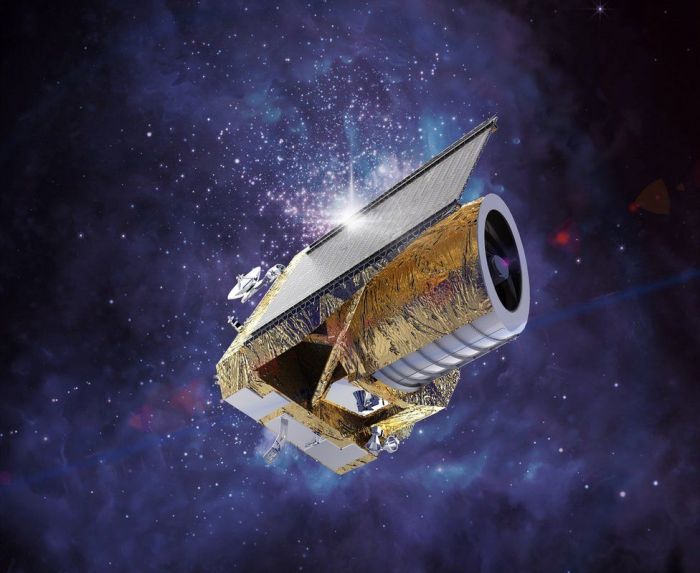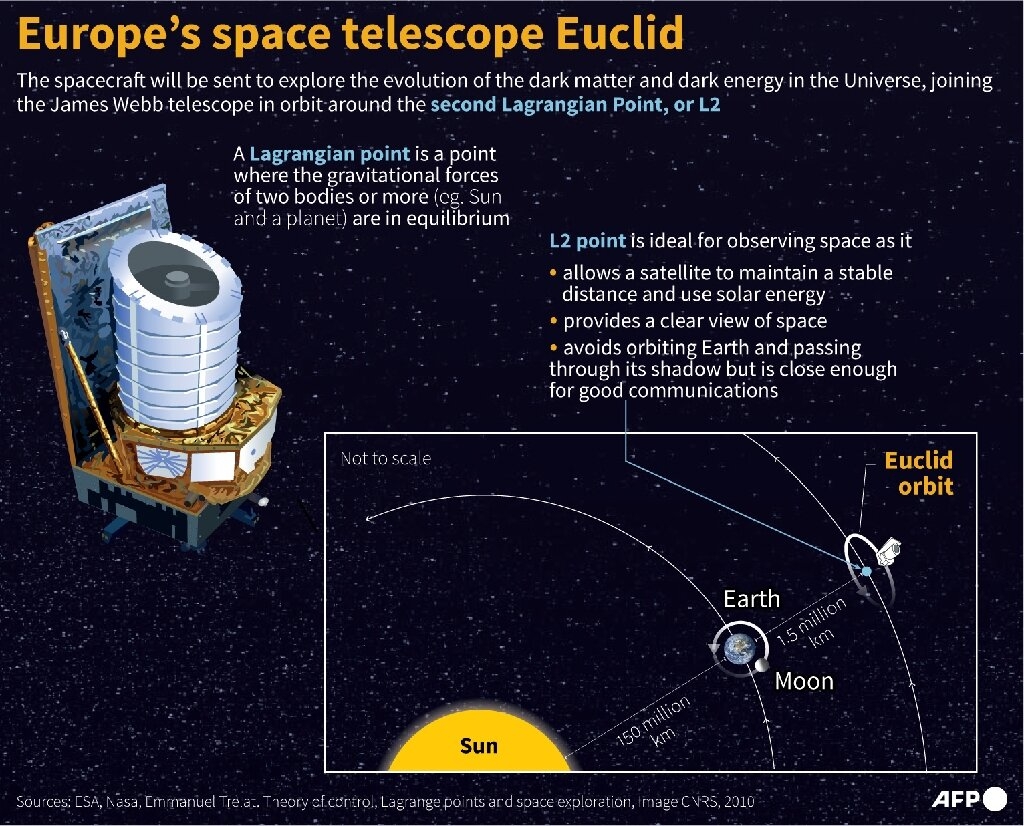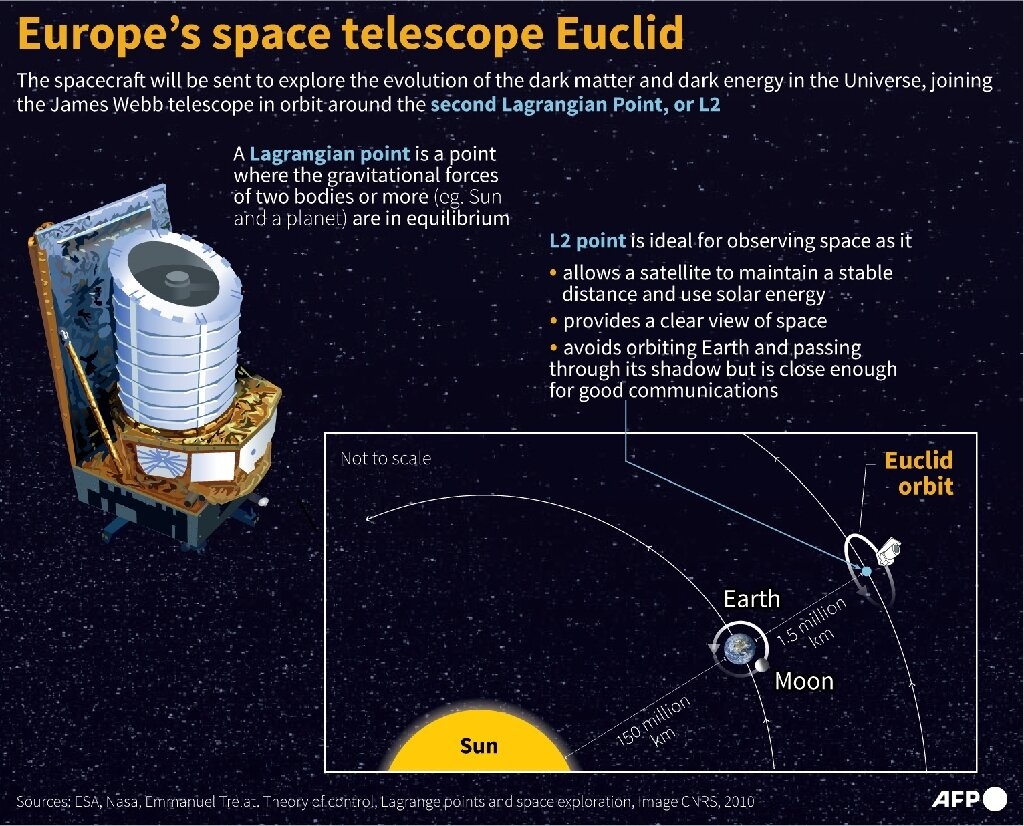Euclid telescope set for dark universe exploration mission – The Euclid telescope, set for a dark universe exploration mission, is poised to revolutionize our understanding of the cosmos. This ambitious endeavor aims to unravel the mysteries of dark matter and dark energy, two elusive components that make up the vast majority of the universe’s mass and energy.
By mapping the distribution of these enigmatic entities, Euclid will provide unprecedented insights into the evolution of the universe, from its earliest moments to the present day.
Equipped with advanced instruments, Euclid will meticulously chart the cosmic web, a vast network of galaxies and clusters interconnected by filaments of dark matter. Through precise measurements of galaxy shapes and positions, scientists will glean crucial information about the distribution of dark matter, allowing them to trace its influence on the formation and evolution of cosmic structures.
Furthermore, Euclid will study the subtle distortions of light caused by dark energy, revealing its impact on the expansion of the universe.
The Euclid Telescope
The Euclid telescope, a collaborative mission between the European Space Agency (ESA) and NASA, is poised to embark on a groundbreaking journey to unravel the mysteries of the dark universe. Its primary objective is to map the distribution of dark matter and dark energy across vast cosmic distances, shedding light on their profound influence on the evolution of the universe.
The Mission’s Objectives
The Euclid mission aims to address fundamental questions about the universe’s composition and evolution, focusing on:
- Mapping the distribution of dark matter:Dark matter, an invisible form of matter, accounts for approximately 85% of the universe’s total mass. Euclid will map its distribution by observing the gravitational lensing effect, where the gravity of massive objects distorts the light from distant galaxies.
This will reveal the intricate web-like structure of dark matter throughout the cosmos.
- Measuring the expansion history of the universe:Euclid will measure the distances to galaxies and map their redshift, which indicates how fast they are moving away from us. This data will provide crucial insights into the expansion rate of the universe and how it has changed over time, shedding light on the nature of dark energy.
- Investigating the nature of dark energy:Dark energy, a mysterious force that is driving the accelerated expansion of the universe, remains one of the most significant enigmas in modern cosmology. Euclid will contribute to unraveling its secrets by precisely measuring the expansion history of the universe and its impact on the large-scale structure of the cosmos.
The Euclid Telescope’s Design
The Euclid telescope is a sophisticated instrument designed to capture the faint light from distant galaxies and map their distribution across a vast expanse of the universe. Its key features include:
- A 1.2-meter primary mirror:This large mirror collects light from distant objects, enabling Euclid to observe faint galaxies with unprecedented detail.
- Two main instruments:
- VIS instrument (Visible instrument):This instrument captures visible light from galaxies, providing information about their shape, size, and color.
- NIR instrument (Near-infrared instrument):This instrument detects infrared light, which is sensitive to the redshift of galaxies, allowing Euclid to measure their distances and velocities.
- A wide field of view:Euclid’s field of view is approximately 0.5 square degrees, allowing it to cover large areas of the sky efficiently.
The Euclid Telescope’s Capabilities
The Euclid telescope’s design and instrumentation provide it with exceptional capabilities for exploring the dark universe:
- High sensitivity:Euclid’s large mirror and advanced instruments enable it to detect faint galaxies that are otherwise invisible to ground-based telescopes.
- Precise measurements:Euclid’s instruments are designed to make highly accurate measurements of galaxy shapes, redshifts, and distances, providing valuable data for understanding the distribution of dark matter and the expansion history of the universe.
- Large-scale mapping:Euclid’s wide field of view and long duration mission will allow it to map the distribution of galaxies across a vast portion of the sky, revealing the large-scale structure of the universe.
Data Analysis and Scientific Impact
The Euclid mission will generate an unprecedented amount of data, which will be analyzed by scientists worldwide. This data will provide crucial insights into the nature of dark matter and dark energy, revolutionizing our understanding of the universe’s composition, evolution, and ultimate fate.
Unveiling the Dark Universe
The universe, as we know it, is a vast and mysterious place. While we can see stars, galaxies, and other celestial objects, these only account for a small fraction of the universe’s total mass and energy. The majority of the universe remains hidden, shrouded in darkness, and is collectively known as the “dark universe.”
The Components of the Dark Universe
The dark universe is composed of two primary components: dark matter and dark energy.
- Dark matteris a hypothetical form of matter that does not interact with light. Its existence is inferred from its gravitational effects on visible matter. It is believed to account for approximately 85% of the total matter in the universe.
- Dark energyis an even more mysterious entity. It is thought to be a form of energy that permeates all of space and is responsible for the accelerated expansion of the universe. It is estimated to account for about 68% of the total energy density of the universe.
The Role of the Euclid Telescope, Euclid telescope set for dark universe exploration mission
The Euclid telescope, a space observatory launched by the European Space Agency, is designed to shed light on the dark universe. It will map the distribution of dark matter and dark energy throughout the cosmos.
- Mapping dark matter: Euclid will use a technique called weak gravitational lensing. This involves observing the distortion of light from distant galaxies caused by the gravitational pull of intervening dark matter. By analyzing these distortions, scientists can create maps of the distribution of dark matter.
- Mapping dark energy: Euclid will measure the expansion rate of the universe over time. This will help scientists understand how dark energy influences the evolution of the universe.
Understanding the Evolution of the Universe
Euclid’s observations will provide crucial insights into the evolution of the universe. By studying the distribution of dark matter and dark energy, scientists can gain a better understanding of:
- The formation of large-scale structures: Dark matter plays a crucial role in the formation of galaxies and clusters of galaxies. Euclid’s observations will help scientists understand how dark matter influences the formation of these structures.
- The accelerating expansion of the universe: Dark energy is responsible for the accelerating expansion of the universe. Euclid’s observations will help scientists understand the nature of dark energy and its impact on the universe’s future.
Exploring the Cosmic Web
The universe isn’t a uniform expanse of stars and galaxies. Instead, it’s structured in a vast, intricate network known as the cosmic web. This web is composed of filaments, sheets, and voids, with galaxies concentrated along the filaments and clusters of galaxies forming at their intersections.
Understanding the cosmic web is crucial for unraveling the mysteries of galaxy formation and evolution, as it reveals the underlying gravitational scaffolding that shapes the distribution of matter in the universe.
Mapping the Cosmic Web with Euclid
The Euclid telescope is designed to map the cosmic web in unprecedented detail. By observing billions of galaxies across a vast swathe of the sky, Euclid will create a three-dimensional map of the universe’s large-scale structure. This map will reveal the distribution of galaxies and clusters, tracing the filaments and voids of the cosmic web.
Further details about how to turn university spinouts in commercial success tnw conference is accessible to provide you additional insights.
Euclid will use two primary methods to map the cosmic web:
- Weak Gravitational Lensing:This technique exploits the fact that massive objects like galaxies and clusters warp the fabric of spacetime, causing light from distant galaxies to be distorted. By measuring the subtle distortions in the shapes of distant galaxies, Euclid can map the distribution of matter, including dark matter, which does not emit light.
- Redshift Survey:Euclid will measure the redshifts of galaxies, which indicate their distances and velocities. By analyzing the distribution of galaxies in redshift space, Euclid can map the cosmic web and study the evolution of its structure over time.
Implications for Galaxy Formation and Evolution
The observations made by Euclid will have profound implications for our understanding of galaxy formation and evolution. By studying the distribution of galaxies within the cosmic web, astronomers can:
- Investigate the role of dark matter in galaxy formation:Dark matter makes up the majority of the universe’s mass and plays a crucial role in the formation of galaxies. Euclid’s observations of the cosmic web will provide valuable insights into the distribution and influence of dark matter on galaxy formation.
- Trace the evolution of galaxies over cosmic time:By mapping the cosmic web at different epochs, Euclid will allow astronomers to study how galaxies form and evolve within the network of filaments and clusters. This will provide a detailed understanding of the processes that drive galaxy growth and evolution.
- Test cosmological models:The structure of the cosmic web is a key prediction of cosmological models, which describe the evolution of the universe. Euclid’s observations will provide stringent tests of these models, helping to refine our understanding of the universe’s fundamental properties.
The Euclid Mission: Euclid Telescope Set For Dark Universe Exploration Mission

The Euclid mission is a testament to the power of international collaboration in scientific exploration. It is a joint endeavor involving numerous countries and institutions, each contributing their expertise and resources to unravel the mysteries of the dark universe.
International Collaboration in the Euclid Mission
International collaboration is crucial for achieving ambitious scientific goals like the Euclid mission. By pooling resources, expertise, and infrastructure, the participating nations can tackle complex challenges that would be insurmountable for any single entity.
- European Space Agency (ESA):ESA is the lead agency for the Euclid mission, responsible for the overall mission design, development, launch, and operations. ESA also provides the spacecraft and its main instruments.
- NASA (National Aeronautics and Space Administration):NASA contributes the Near-Infrared Spectrometer and Photometer (NISP), a key instrument for measuring the redshifts and properties of galaxies. NASA also provides support for ground-based observations and data analysis.
- Canadian Space Agency (CSA):CSA is responsible for developing and building the Visible Instrument (VIS), which will capture images of galaxies in visible light. The CSA also contributes to data analysis and scientific exploitation.
- Numerous Other Countries and Institutions:Beyond the lead agencies, numerous other countries and institutions contribute to the Euclid mission. These include universities, research institutes, and industrial partners from across Europe, the United States, Canada, and other nations. These contributions encompass a wide range of activities, such as instrument development, data processing, scientific analysis, and outreach.
“The Euclid mission is a prime example of how international collaboration can advance scientific knowledge and understanding. By bringing together the best minds and resources from around the world, we can achieve what would be impossible alone.”
[Name of prominent scientist or official]
The Legacy of the Euclid Telescope

The Euclid mission is not merely a snapshot of the universe but a cornerstone for future generations of scientists and researchers. It will leave behind a treasure trove of data that will fuel scientific inquiry for decades to come. The mission’s discoveries will reshape our understanding of the universe’s evolution, dark energy, and the fundamental laws of physics.
Impact on Cosmology and Fundamental Physics
The Euclid mission’s data will provide unprecedented insights into the distribution of dark matter and dark energy, which constitute the vast majority of the universe’s energy density. This data will allow cosmologists to refine our understanding of the universe’s expansion history, the nature of dark energy, and its role in shaping the cosmic structure.
Furthermore, the mission’s observations will test fundamental theories of gravity and cosmology, potentially leading to new discoveries about the nature of space and time.
The Euclid mission is expected to revolutionize our understanding of dark energy, one of the most fundamental mysteries in modern physics.
Contributions to Future Research
The Euclid mission’s data will serve as a foundation for future research in various fields. For instance, the detailed maps of the cosmic web will be invaluable for studying the formation and evolution of galaxies, clusters of galaxies, and large-scale structures in the universe.
Furthermore, the mission’s observations will provide crucial information about the properties of dark matter, potentially shedding light on the nature of this enigmatic substance.
The Euclid mission’s data will be a gold mine for researchers studying the evolution of galaxies, the formation of large-scale structures, and the nature of dark matter.





